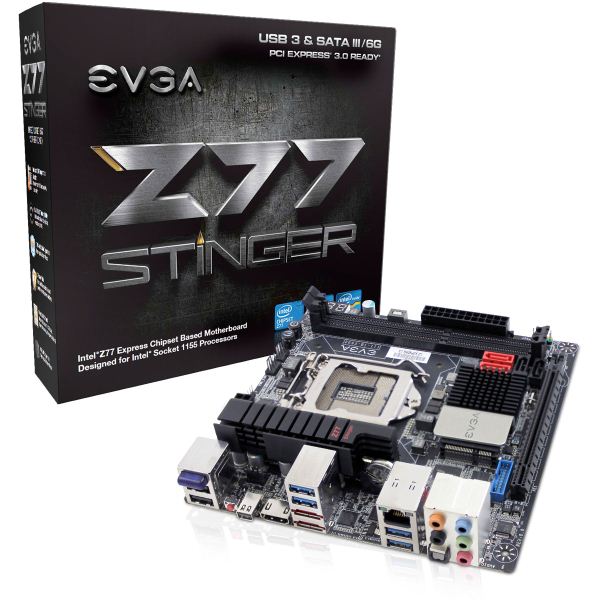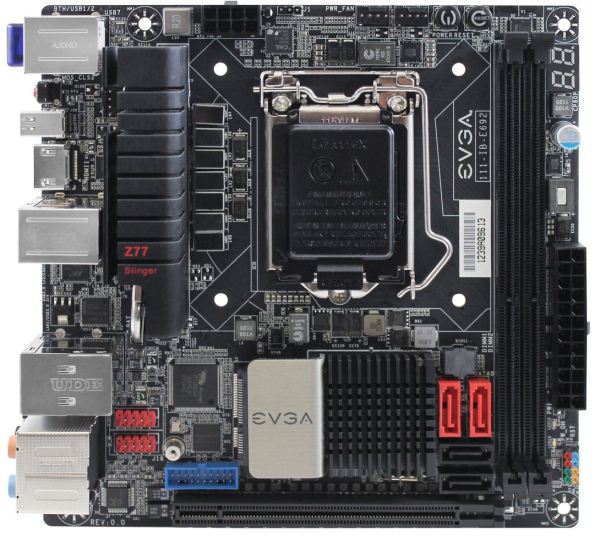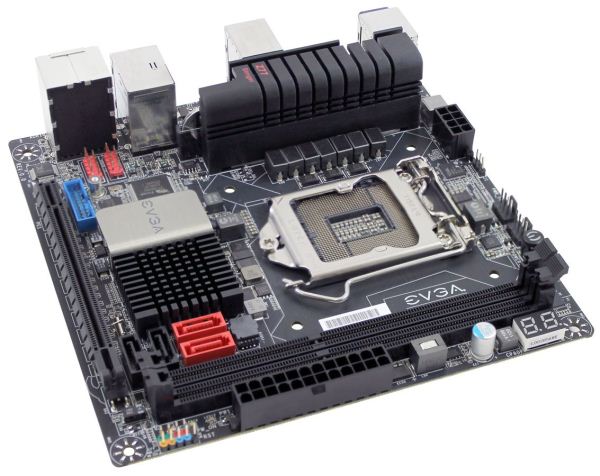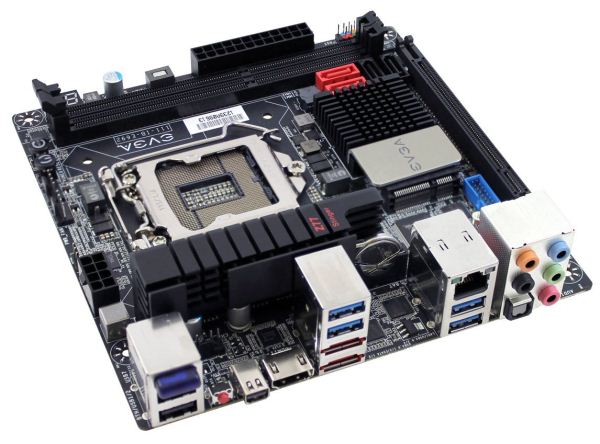Z77 mITX Round-Up: Five of the Best – MSI, Zotac, ASRock, EVGA and ASUS
by Ian Cutress on December 31, 2012 7:00 AM EST- Posted in
- Motherboards
- MSI
- ASRock
- EVGA
- ZOTAC
- Asus
- Ivy Bridge
- Z77
- mITX
EVGA Z77 Stinger Overview
For the fourth motherboard of this review, the design philosophy of the Z77 mITX board takes a turn on its head – almost literally. We find the socket moved to the top, and the chipset placed underneath. This ultimately gives more freedom when it comes to placing CPU coolers, albeit the EVGA Z77 Stinger is still limited in one dimension due to the close proximity of the memory slots. Users can happily place a longer cooler in the other direction though.
As a price of $200, it certainly raises the asking cost for a mITX board to new heights. A good number of great ATX sized motherboards are already at this price, including a few we have awarded. This instantly makes the EVGA a tougher sell, but in order for a little compensation, EVGA get heavy handed with some of the features.
We get an Intel NIC on board unlike the other mITX so far, but on the downside it is coupled with the Realtek ALC889 which failed our 192 kHz testing. We get a mini-PCIe slot, though with no WiFi module like with some of the other boards. EVGA have decided to up the total USB 3.0 count to six with an ASMedia controller powering the onboard header as well as upping the SATA 6 Gbps count with a Marvell controller powering the two eSATA 6 Gbps on the rear IO. The EVGA is also one of few boards to have the power/reset button combination with a debug LED that changes to a CPU temperature monitor after POST. If anything the rear IO looks a little sparse, with HDMI and mini-DisplayPort being the only options for video output. It looks like some of the connectivity had to be lost in order to fit a couple of the controllers on board.
EVGA are still not completely on the bandwagon with a graphical and interactive BIOS, showcasing a white text on black scenario. To make matters worse, XMP is not properly implemented in the first BIOS release, and returning to optimized defaults changes everything back to normal except the BCLK. On the software side, the driver install is a one-by-one affair which requires user interaction despite the fact that these driver installs when sent to EVGA offer silent install modes. The only software we get is EVGA E-LEET which allows the user to adjust the overclocks and priority of programs on the fly – it is for all intents and purposes an advanced version of CPU-Z. Fan control is not in the software – that is solely for the BIOS.
Performance of the EVGA is on par with the other motherboards tested – nothing comes out as overly great or bad. This makes a $200 mITX a tough sell – it has the socket position I prefer and an Intel NIC, but the support behind the motherboard in terms of the BIOS or Software pale in comparison to the cheaper models. One upside of purchasing an EVGA board is that all RMA requests are direct with EVGA rather than the supplier, which may add to that additional cost as well.
Visual Inspection
As noted in the overview, the main comparison with the previous motherboards and the EVGA is the location of the socket area. Here the socket is above the chipset, which changes a lot to do with port location. Our 8-pin CPU power connector is now at the top edge of the board with a pair of four-pin fan headers. As the chipset is underneath the socket, so are the USB 2.0 and USB 3.0 headers and the SATA ports. The result is a mixed bag, with USB cables having to stretch over components in order to fit into the board.
Unlike most of the other mITX boards, we get three fan headers – two located to the top right of the socket (both 4-pin) and another on the rear IO side of the power delivery heatsink (also 4-pin). The socket area still caters in the left-right direction to the Intel minimum specifications, meaning that coolers that conform to at least one of the dimensions should be placed such that any full sized memory does not interfere.
With the chipset below the socket, our SATA ports are in the bottom right area between the memory slots and the PCIe device. The orientation of the SATA ports is going to give issues if any need to be taken out, requiring most of them to be removed each time. To the left of the chipset is a mini-PCIe (not mSATA) port for a WiFi/WiDi module, which is not included in the package – this is in contrast to the other mITX motherboards tested which do have one.
Along the top right of the motherboard are a pair of power/reset buttons which I always find useful in testing. To the right of these is a two-digit debug LED, also useful for diagnosing issues. This two-digit debug LED turns into a CPU temperature readout after POST, which is an awesome feature to have. Unlike some other mITX builds, the Front Panel connector is found at the bottom right of the motherboard in an ideal location for most orientations.
The rear IO panel is a little different to the previous motherboards tested. Normally the rear IO is fighting for space to fit in all the different connectors wanted on the product, but EVGA have decided to cut some of the fluff and stick to components they think most of their users will want to use. From left to right we have a BlueTooth module, two USB 2.0 ports, a Clear_CMOS button, a mini-DisplayPort, HDMI, four USB 3.0, two eSATA 6 Gbps, an Intel NIC, and audio jacks from the Realtek ALC889.
Board Features
| EVGA Z77 Stinger | |
| Price | Link |
| Size | Mini ITX |
| CPU Interface | LGA-1155 |
| Chipset | Intel Z77 |
| Memory Slots |
Two DDR3 DIMM slots supporting up to 16 GB Up to Dual Channel, 1066-2133 MHz |
| Video Outputs |
HDMI mDP |
| Onboard LAN | Intel 82574L |
| Onboard Audio | Realtek ALC889 |
| Expansion Slots |
1 x PCIe 3.0 x16 1 x mPCIe |
| Onboard SATA/RAID |
2 x SATA 6 Gbps (Chipset) RAID 0, 1, 5, 10, 0+1 2 x eSATA 6 Gbps (Marvell) RAID 0, 1, 5, 10, 0+1 2 x SATA 3 Gbps (Chipset) RAID 0, 1 |
| USB |
4 x USB 3.0 (Chipset) [4 back panel] 2 x USB 3.0 (ASMedia ASM1042) [2 onboard] 6 x USB 2.0 (Chipset) [2 back panel, 4 onboard] |
| Onboard |
2 x SATA 6 Gbps 2 x SATA 3 Gbps 1 x USB 3.0 Header 2 x USB 2.0 Headers 1 x Front Panel Header 3 x Fan Headers Power/Reset Buttons Debug LED |
| Power Connectors |
1 x 24-pin ATX Power Connector 1 x 8-pin CPU Power Connector |
| Fan Headers |
1 x CPU (4-pin) 2 x PWR (4-pin) |
| IO Panel |
1 x Bluetooth Module 2 x USB 2.0 1 x Clear_CMOS Button 1 x mDP 1 x HDMI 4 x USB 3.0 2 x eSATA 6 Gbps 1 x Intel NIC Optical SPDIF Output Audio Jacks |
| Warranty Period | 3 Years |
| Product Page | Link |
For the large $200 price tag for the Z77 Stinger, the lack of a WiFi module on board is a little disappointing, as well as the use of the Realtek ALC889 rather than anything higher up the Realtek order catalogue. On the plus side we do get an Intel NIC, an additional USB 3.0 controller, an additional SATA 6 Gbps controller (for eSATA ports) and, in my opinion, a better oriented mITX motherboard. Also that third fan header is one more than most mITX motherboards.














54 Comments
View All Comments
Etern205 - Saturday, January 5, 2013 - link
Here is another model, that supports WiDihttp://www.asus.com/Motherboards/Intel_Socket_1155...
zilexa - Friday, January 11, 2013 - link
Will the upcoming Intel CPUs with integrated GTe graphics chip fit on these mobo's? If so these mITX mobos are VERY futureproof and ideal for an HTPC.doubledd - Wednesday, April 10, 2013 - link
I recently built a mini itx with the MSI Z77IA-53, Cooler Master Elite 120, Antec Kuhler 620, 16gb 1.35V ballistic memory, a 690GTX, a 3570k, default timings and a msata plextor SSD. Except the video card, the system was dirt cheap. With the card, 3D Mark 11 score of X6037.Removal of the HDD cage was all that was required to make room for the radiator to mount to the existing front fan on this $45 case. Folding 100% load processor is 64 degrees....not great, but manageable for this BEAST.
While I consider Anandtech to be one of my trusted sources in reviews, I find it disappointing that they could be reviewing mini itx systems and yet be so out of touch with what people actually use these for. These are lan boxes or HTPCs and are supposed to be small and quiet. Why anyone would want a 8" tall by 8" diameter fan is beyond me. These boards are hardly bigger than a post card. Things are gonna be tight. Think out of the box a bit huh? There are quite a few mini-itx cases that can run or be modded with little effort to run, quiet liquid cooling.
It reminds me of the Consumer reports worst cars of 2013. Half of them are off road vehicles. The complaints are about suspension, shifting and road noise......no kidding?
castl3bravo - Sunday, June 23, 2013 - link
I have found the Asus BIOS for my P8Z77-I Deluxe to be an abysmal mess. My CPU ratio is permanently stuck at 42. During some change of a setting or an upgrade to the latest BIOS, ASUS shoved a "hidden" ME upgrade as well. This process somehow corrupted my BIOS so now I can't overclock beyond ratio of 42.There are other ASUS P8Z77 based m/b's having the same issue. I would suggest Anand have his team research the forums first before writing such glowing reviews of the BIOS for a vendor. I bought this board based on, what appears to be, an inexperienced review last year. Reading this followup on the BIOS is laughable--perhaps even negligent.
Here is but one example of the drama people are going through with this messed up BIOS.:
http://forums.anandtech.com/showthread.php?t=23143...